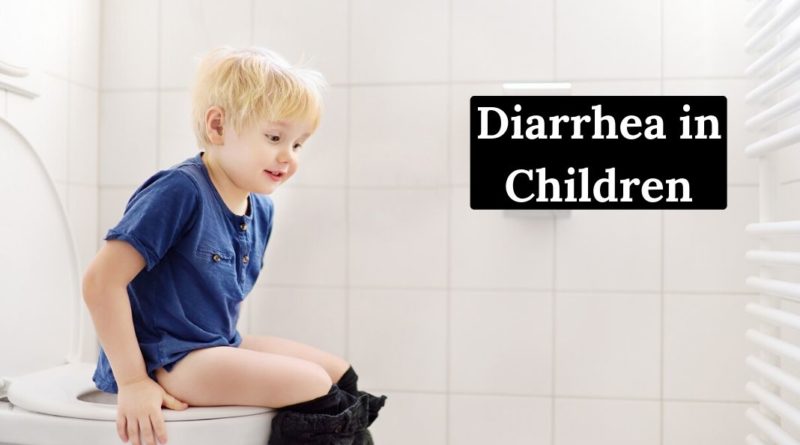Diarrhea in Children: Causes, Symptoms, and Treatment
The word diarrhea comes from the Greek dia (through) and rhein (to flow).
Table of Contents
What is diarrhea?
It is one of the most frequent problems that the pediatrician encounters in his daily consultation, especially during the summer as it is the hottest time.
Diarrhea is a process characterized by an increase in the number of stools, associated or not with a decrease in their consistency (they are generally more liquid than normal). In addition, it can produce fever and many times a great general malaise (1).
[Also Read: Constipation and its Causes]
Importance of diarrhea in childhood
Diarrhea is the most common cause of illness and death in childhood worldwide. It is estimated to cause approximately more than 3 million annual deaths of children under the age of 5, especially in underdeveloped countries. In any case, it is more frequent at younger ages, especially in children under the age of three.
It is also one of the most frequent causes of hospital admission, especially due to dehydration. The vast majority of hospital admissions for diarrhea, and deaths, are mainly due to inappropriate treatment, which causes significant symptoms of dehydration.
What should we not confuse diarrhea
Newborns and infants fed breast milk generally have yellowish or greenish stools, of a fairly light consistency (almost liquid) and explosive in nature. This type of stool is usually done after each breastfeeding and should not be confused with diarrhea, either because of its frequency or its consistency, since they are completely normal.
This phenomenon is called “false diarrhea” and differs from true diarrhea in that the child maintains a good appetite and gains weight appropriately. It is due to an intestinal reflex called “gastrocolic reflex” that tends to decrease in intensity as solid foods are incorporated.
Most frequent causes of diarrhea
The main causes of diarrhea in childhood are usually infectious. Acute diarrhea can be caused by different infectious agents: viruses, bacteria, or parasites.
What are the causes of diarrhea
The germs that cause diarrhea can work:
- directly injuring the mucosa of the wall of the intestine (this depends on the invasive capacity of the germ).
- or through the production of toxins that cause diarrhea.
Depending on the mechanism used by the offending agent to cause diarrhea, it can be classified into 4 different types:
Secretory diarrhea
Germs cause the lining of the intestine to secrete substances rich in chlorine and bicarbonate and to lose a large amount of water (it is mainly liquid diarrhea).
Osmotic diarrhea
Osmotic substances are produced within the intestine, that is, substances that themselves carry a large amount of water.
Invasive diarrhea
It is diarrhea with mucus, blood, and incontinence, all this caused (as we have said before) by the direct injury of the germ on the lining of the intestine, which causes inflammation and ulceration of said mucosa.
Diarrhea due to impaired normal motility of the intestine
It is caused by the abnormal growth of certain germs that normally inhabit the intestine.
Clinic of diarrhea according to the germ that causes it
The accompanying symptoms of acute diarrhea depend mainly on the germ that originates it and the causative mechanism:
- Invasive germs (Campylobacter, Salmonella, E. Coli, and Yersinia e.) Usually produce a significant alteration of the general state, fever, abdominal pain, and abundant diarrhea with blood.
- Toxicogenic germs (cholera, etc.) cause profuse watery diarrhea and are usually accompanied by vomiting.
- Rotavirus infections cause fever and vomiting, followed by watery and yellow diarrhea, acidic stools (due to the lactose intolerance caused by diarrhea itself) that greatly irritate the baby’s bottom.
- There are diarrheas that are produced by respiratory viruses (adenovirus, coxsackie) that are also accompanied by respiratory symptoms.
Diagnosis of the cause of diarrhea
As seen previously, clinically we can deduce whether the germ that produces diarrhea is a virus or an invasive bacterium. For example, high fever and poor general conditions indicate that it is an invasive germ, while fever and accompanying respiratory symptoms indicate that the cause may be viral.
The appearance of stool can also guide us for diagnosis (macroscopic study). For example, a stool with mucus, blood, or pus indicates that it is an invasive germ, while a yellowish stool that irritates the baby a lot means that the cause is viral.
In any case, the only way to find out the real cause of the diarrhea is to carry out a culture of a sample of the child’s feces (stool culture). However, since the treatment of diarrhea does not vary, regardless of the cause that causes it, stool culture is not essential, unless the pediatrician deems it appropriate.
Assessment of the child’s hydration status
The most important thing, when faced with diarrhea, is that the child does not become dehydrated. Dehydration is the most serious, and we should be concerned immediately.
For this reason, the pediatrician must always take into account the following:
- Weight: It is important to have a reference for the child’s weight just before the onset of diarrhea. If this is not possible because the child has not attended the consultation for a long time, the weight will be taken at that time to be able to observe if there is weight loss in the following days. If there was a large weight loss in a short time, it would indicate dehydration and the pediatrician will decide if it is necessary to send the child to a hospital center.
- Number and characteristics of bowel movements: it is important to know the cause of diarrhea, and to assess its severity.
- Skin turgidity: when a child is dehydrated, their skin loses turgidity and is dry, reaching in extreme degrees the sign of the fold appears (the skin stays in the shape of a fold when we pinch it because it does not return to its initial position due to lack of elasticity).
- Fontanelle: if it is an infant, it will be taken into account if the fontanelle has a normal tension or if, on the contrary, it is sunken (the sign of dehydration).
- Hydration of the mucous membranes: the lips, the mucosa of the mouth, the presence or not of saliva, and whether or not the child has tears when crying, or if he has sinking eyes will be observed.
- General state affectation: if the child is down, clouded, etc. Presence of other accompanying symptoms that may contribute to further dehydration: vomiting, fever.
Diarrhea treatment
The treatment of diarrhea in the child includes two phases:
Rehydration phase
Your goal is to correct dehydration.
It will be done by oral administration of a rehydration solution that will be prescribed by the pediatrician. These formulas contain glucose and the necessary electrolytes that are lost in the stool. They are usually low in sodium so as not to provide it in excess, but it should always be consulted since the composition varies from one to the other.
Never use homemade formulas or disadvantaged soft drinks or sports drinks for rehydration, as they do not provide the necessary nutrients, and can provide excessive salt to the child that can worsen the initial dehydration.
Normally the duration of rehydration depends on the degree of dehydration, but it usually lasts between 4 and 6 hours (always supervised by the pediatrician).
It will be done in small fractional shots (with a teaspoon).
Early feedback phase
Feeding should be started as soon as possible as soon as the child has rehydrated.
If the child is taking breast milk, it must be continued. If you are drinking artificial milk, you should initially dilute the feedings and gradually increase the concentration of the bottles as stool improves. As a general rule, the use of a lactose-free formula is not indicated, unless recommended by the pediatrician.
Older children should follow an astringent diet for a few days: eliminate fatty foods, cereals (except rice), and products that are high in simple sugars (juices, sodas or sugary teas).
Contraindications
- Inhibiting substances for intestinal motility (Loperamide …).
- Substances that alter intestinal secretion (Bismuth).
- Substances that promote the adsorption of toxins (pectins, activated carbon …).
- Agents that alter the intestinal microflora (lactobacilli).
- Antibiotics will only be used on rare occasions: certain germs, malnourished or immunodeficient children at risk of blood infection. The indiscriminate use of antibiotics in diarrhea favors the state of the carrier, that is, it can safely be contagious and with periodic episodes of diarrhea for a long time.
Prevention of diarrhea
Acute diarrhea is an easy disease to prevent if we take adequate hygiene, educational, and public health measures.
First of all, breastfeeding should be favored, as it is much more hygienic and has greater immunological advantages (greater contribution of defenses to the child).
Nowadays nurseries are the places where there is a greater risk of contagion from infectious diseases. With close contact between staff and children, the germs that cause diarrhea can be transmitted both directly (from child to child) and indirectly through the hands of daycare staff. For this reason, you must be especially careful with handwashing, especially when changing diapers and before eating. There are also germs, such as rotavirus and G. lamblia, that can survive on hard surfaces, so environmental surfaces, toys, and objects that children touch and put in their mouths need to be cleaned.
It should be advised that all children with diarrhea do not attend class until they are cured.




